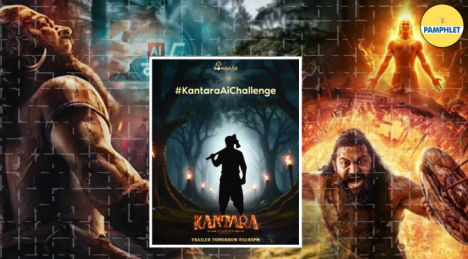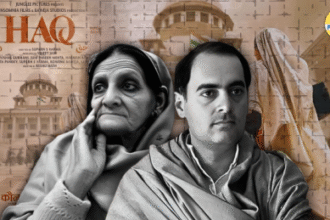Indian cinema has always thrived on spectacle, whether through mythology, folklore, or grand cinematic universes. But now, the industry is experimenting with something new, artificial intelligence as a partner in storytelling and marketing. Nowhere is this more visible than in Hombale Films’ ambitious campaign for Kantara: Chapter 1.
Ahead of its October 2, 2025, multilingual release, the makers launched the Kantara world AI prompt challenge—a fan-driven initiative that invites audiences to place themselves directly into the mystical world of the film.
The Kantara world AI prompt challenge
The campaign is simple but striking. Fans upload full-length photos, which are then transformed through a custom-designed AI prompt into cinematic artworks set in Tulunadu’s foggy forests. The generated visuals are infused with the film’s atmospheric elements, moonlight breaking through trees, the glow of torchlight, and even a rustic axe resting on the fan’s shoulder, turning everyday participants into mythic warriors.
These creations are then shared online with the hashtag #KantaraAiChallenge, making fans not just viewers but co-creators of the cinematic universe. By blurring the lines between promotion, fan art, and folklore, Hombale Films has introduced a campaign that feels both deeply cultural and radically modern.
Immersion before the screen
Unlike typical film promotions that rely on trailers, teasers, or star-driven interviews, this initiative immerses audiences in Kantara’s world before the screen lights up. The campaign resonates because Kantara itself is a film that celebrates atmosphere—its forests, rituals, and spiritual undertones are characters in their own right.
By inviting fans to visualize themselves inside this mystical space, the promotion creates an emotional pre-release connection. Long before the first scene unfolds, audiences already feel like they belong to the story.
Mystical roots on screen
The narrative of Kantara: Chapter 1 further strengthens this bond. Unlike its 2022 predecessor, which told a contemporary tale infused with folklore, the prequel delves into the very origins of Bhuta Kola, the ritual dance that forms the cultural heartbeat of Tulunadu.
It seeks to trace the emergence of the divine spirits that guided the story in the original film, offering viewers a spiritual and cultural genesis tale. For fans, this is not merely a return to the forest but a journey deeper into its soul.
In that sense, the AI campaign is more than a marketing gimmick—it symbolically mirrors the film’s themes. Just as Kantara: Chapter 1 bridges tradition and mysticism, its promotions bridge heritage and technology.
AI as the new marketing frontier
This innovation is not happening in isolation. Indian cinema is increasingly experimenting with AI in both promotion and production. Some recent examples stand out:
- Ramayana AI series: Cinefai Studios in Mumbai used AI to reimagine the epic Ramayana as a limited web series. With AI-generated characters and landscapes, it gave a fresh, futuristic look to an ancient tale, receiving praise for visual boldness.
- Bollywood film campaigns: Major releases like Shah Rukh Khan’s Jawan, Vicky Kaushal’s Sam Bahadur, and Kriti Sanon’s Teri Baton Mein Aisa Uljha Jiya incorporated AI-driven tools—AI anchors, fan chatbots, personalized trailer cuts—making campaigns more interactive.
- Naisha (2025): Heralded as India’s first fully AI-powered feature film, Naisha was built entirely using AI-generated characters and visuals, sparking debates about creativity, authenticity, and the future of storytelling.
- Shekhar Kapur’s Warlord: A sci-fi series created entirely with AI, it demonstrated that Indian filmmakers are not shying away from using technology as the core engine of production, not just a supporting tool.
Together, these examples suggest a paradigm shift: AI is no longer a futuristic add-on; it is becoming a mainstream partner in cinematic expression.
Storytelling meets technology
What makes Kantara’s campaign unique is that it doesn’t use AI simply for novelty—it uses it to reflect the story’s essence. Kantara has always been about the coexistence of the mystical and the real. By using cutting-edge AI to reimagine ancient folklore, the makers are embodying the very tension their narrative celebrates: the meeting point of tradition and innovation.
For audiences, this offers a layered experience. They are not only anticipating a film but also participating in a ritual of imagination, where technology becomes the medium through which folklore is reinterpreted.
The cultural edge
Unlike Western AI campaigns, which often focus on futurism or sci-fi aesthetics, Indian cinema’s experiments frequently draw on mythology, spirituality, and cultural heritage. This cultural grounding makes the campaigns feel authentic rather than artificial.
In Kantara: Chapter 1 promotion campaign, the AI artworks are not just aesthetic—they carry the visual codes of Tulunadu’s landscape, Bhuta Kola’s mysticism, and the earthy grit of its people. That cultural context prevents AI from being an alien intrusion; instead, it becomes a digital extension of tradition.
The road ahead
The success of such campaigns raises an important question: Is AI the future of film promotions?
On one hand, the benefits are clear—personalized fan engagement, viral campaigns, cost-effective production, and immersive experiences that trailers alone cannot deliver. On the other hand, challenges remain: concerns about creative authenticity, overreliance on technology, and the risk of alienating audiences who crave the human touch in art.
Yet, the trajectory seems undeniable. As Kantara: Chapter 1 demonstrates, when used thoughtfully, AI can enhance the cultural and emotional weight of cinema rather than dilute it.
Final take
Indian cinema is at a fascinating crossroads. With films like Kantara blending ritual and roots with AI and innovation, audiences are witnessing the birth of a new promotional language. What once required posters, hoardings, and TV spots is now unfolding through AI prompts, fan-driven art, and immersive digital storytelling.
As the forests of Tulunadu prepare to echo once again with the rhythms of Bhuta Kola, Kantara: Chapter 1 is proving that cinema’s future lies not just in what happens on screen but also in how films invite us into their world long before the first frame rolls.
And in that invitation, AI might just be the bridge between mythology and modernity, folklore and future.






